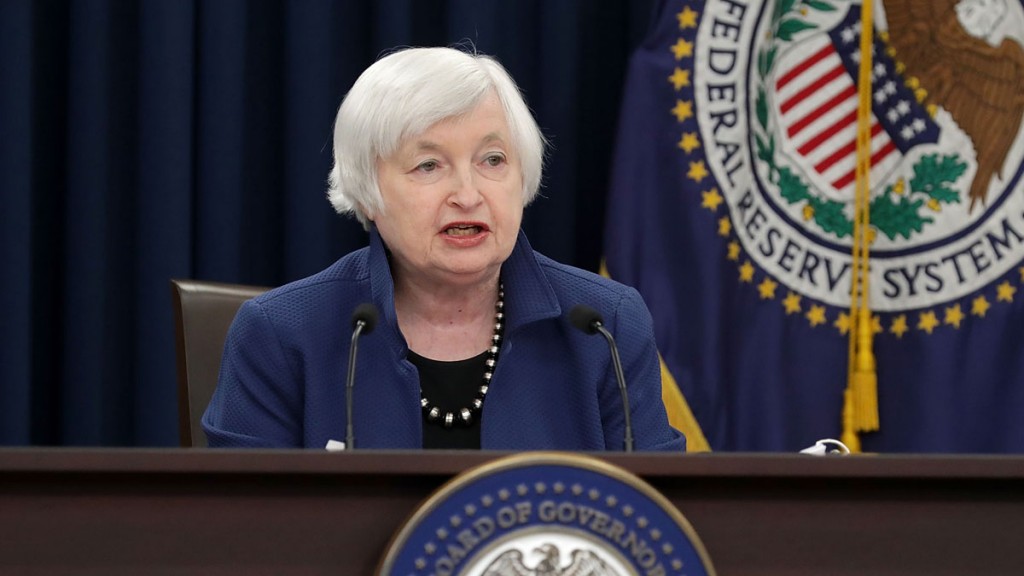
This week, the US Federal Reserve produced the least surprising interest rate rise since the last one.
Market expectations for a 0.25% rate rise on Wednesday had hit 100%.
Federal Reserve boss Janet Yellen did nothing to undermine that level of certainty, as you’d expect. And so rates were duly raised.
The US federal funds rate is now 0.75% to 1%. No surprises there.
So if everyone was expecting it, then why did the market – and gold – shoot up, and the dollar slide?
Why was the market so excited about the US rate rise?
The market was well warned about this week’s interest rate rise from the Federal Reserve. Various members of the US central bank had been running around telling everyone that it was time for rates to go up. So by the time Wednesday rolled around, the deal was in the bag.
Equally, the Fed’s various officials didn’t make many changes to their forecasts for where interest rates will end up, or what the economy will be doing over the next couple of years. They reckon there will be three rate rises in total this year, including this most recent one.
Meanwhile, economic growth is expected to come in at around 2% a year for the next three years, unemployment is forecast to remain around 4.5%, and inflation is expected to be on target – at 2% – by 2018, notes Paul Ashworth of Capital Economics.
The only mild surprise was that one Fed policy maker – Neel Kashkari – voted against raising rates at all. That by itself wouldn’t have made much difference though.
So why the extremely relaxed reaction from the market?
Well, it looks as though investors were simply worried that the Fed might become a lot more aggressive all of a sudden. That didn’t happen.
And when Fed chair Janet Yellen then seemed in no great hurry to stem markets’ exuberance – saying that monetary policy will remain accommodative for “some time” – that was all the reassurance they needed.
You see, as we’ve mentioned here a few times, what really matters for asset markets isn’t the level of nominal interest rates. It’s the level of “real” interest rates. That’s interest rates once you take account of inflation.
With inflation at about 2% and the Fed rate at about 1%, the real interest rate is negative. And if inflation continues to rise more rapidly than interest rates do, then real rates could go lower, even as nominal rates are rising.
As Wayne Gordon of UBS told Bloomberg, if Yellen sticks to the current plan of three rate rises this year, then “that means real interest rates go deeper into negative territory in the US, that means a weaker US dollar, and it means a better gold price”.
And that’s exactly what happened. Gold headed higher – leaping up by $20 an ounce – and the dollar weakened.
Meanwhile, ten-year US Treasury yields retreated (which means they moved further away from the key 2.6% level that – according to Bill Gross at least – marks the end of the bond bull market) too.
How long will the good times roll on for?
How long can this “Goldilocks” environment continue?
The reality is that it can probably carry on for as long as the Fed remains “behind the curve” (ie not tightening monetary policy at all).
Where it gets tricky, of course, is when inflation gets to the point where it’s hard to ignore. But if oil prices remain around these levels (or even fall a bit), then that might buy the Fed some more time.
And given that Donald Trump’s promised infrastructure spending and tax cuts (which you’d expect to be inflationary) may not materialise as rapidly as some had hoped, it’s possible that the Fed will remain comfortably behind the curve for most of this year at least.
Of course, when markets become convinced that the Fed really isn’t going to get ahead of inflation, that will become particularly tricky for bonds. But we’ll discuss that another time.
In terms of what it all means for your investments, it’s relatively straightforward. If you have a Fed that is jogging along slowly, chasing inflation but not particularly enthusiastically, then that’s a green light to buy commodity stocks, gold, and emerging markets. As long as the dollar remains quiescent – and with a dovish Fed, it should – then life should be good for all of those asset classes.
In terms of my own portfolio, I’m looking closely at taking another bite at the gold miners. They’re well off the peaks they saw last year, but if sentiment shifts to being more bullish on gold once again, it could be time for them to enjoy another sustained rally.